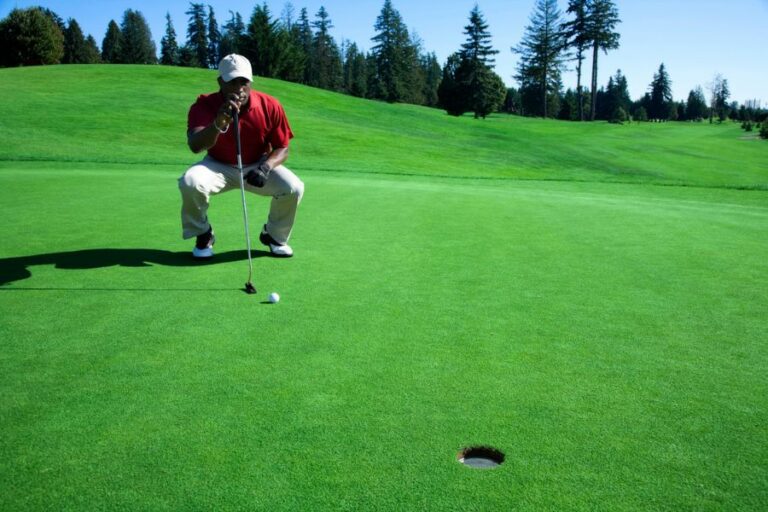What Is A Condor In Golf?

What is a condor in golf? Discover the rarest feat in golf. Get to know how it’s achieved and more in our ultimate guide!
If you’re an avid golfer, you may have heard of the “condor,” a term used to describe an extremely rare feat in the sport.
A condor refers to scoring four shots under par, which is only possible on par-5 holes for most golfers.
This article will explore the history of the condor, the players who have achieved it, and its incredible accomplishments.
What is a condor in golf?
In golf, a “condor” is an incredibly unusual score that happens when a golfer completes a hole in four strokes under par.
There have been only a few documented instances of them throughout the history of the sport. Although condors are rare, they do occur more frequently in amateur or casual golf, where players may be more inclined to take risks and make more aggressive shots.
To score a condor, a golfer generally needs to hit a very long and precise shot off the tee, followed by a second shot that is positioned perfectly to set up a clear path to the green. After that, the player must make a lengthy putt to finish the hole in four strokes under par.
The first condor ever recorded
Due to the rarity of condors in golf and the lack of documentation in the early days of the sport, it is challenging to determine the exact date of the first Condor. However, the first confirmed occurrence of a condor was in 1962 when golfer Larry Bruce achieved the feat.
He accomplished this incredible shot on the fifth hole of the Hope Country Club in Arkansas, USA. The hole was 480 yards long and required the ball to go over the trees to make it in four strokes under par. While there have only been a handful of condors since then, Bruce’s historic achievement is still remembered by golf enthusiasts worldwide.
Others who have recorded condor
Here’s a list of notable golf players who have achieved the rare and impressive feat of a condor, including the date, yardage, venue, and location where the remarkable shots took place.
| Player Name | Year | Yardage | Venue | Location |
| Larry Bruce | 1962 | 480 | Hope Country Club | Arkansas, USA |
| Dick Hogan | 1973 | 456 | Piedmont Crescent Course | Burling, North Carolina, USA |
| Shaun Lynch | 1995 | 496 | Teign Valley Golf Club | Christow, England |
| Mike Crean | 2002 | 517 | Green Valley Ranch Golf Club | Denver, Colorado, USA |
| Jack Barlett | 2007 | 513 | Royal Wentworth Falls Country Club | New South Wales, Australia |
| Kevin Pon | 2020 | 667 | Lake Chabot Golf Course | Oakland, California, USA |
Condor shot in the PGA/LPGA Tour
As of January 2022, no player in the PGA Tour or U.S. Open has ever hit a condor shot. While this feat is incredibly rare, there have been instances where amateur golfers have achieved it. The odds of hitting a condor shot are at least one in a million, with some experts believing the chances are even greater. Nonetheless, this elusive achievement remains a highly sought-after goal for many golfers.
Is condor rare in golf?
Experts estimate that the odds of hitting a condor are at least a million to one, making it a highly elusive achievement. This is because it requires a combination of exceptional accuracy, great distance off the tee, precision in the second shot, and, finally, sinking a long putt. Although some amateur golfers have achieved this rare shot, it is almost unheard of in professional golf tournaments.
Can you get an up and down and a condor in one shot?
It is possible to score both an up and down and a Condor on the same shot in golf.
An up and down shot is when the golfer gets the ball in the hole on their second shot. This usually occurs when a golfer hits the ball deep down the fairway with their first stroke and then needs only one more shot to put the ball into the hole.
If the hole is a par 6, and the golfer completes it in just two strokes, then they have achieved both the up and down and condor accomplishments.
Tips to aim for a Condor
Aiming for a condor may seem like an impossible task, but with the right tips and techniques, you can turn that dream into a reality:
- Choose the right club: Use a driver or fairway wood with a low loft for maximum distance off the tee.
- Aim for the right spot: Select a spot on the fairway that gives you the best angle to reach the green in two shots.
- Hit the ball accurately: Strike the ball with precision and maximum distance off the tee.
- Choose the right second shot: Choose a club that gets you close to the green without overshooting.
- Putt well: Finish the hole with the fewest strokes possible by putting well on the green.
- Play on multiple courses: Train on different course types to adapt to various conditions.
- Practice consistently: Regular practice can help you improve your accuracy, distance, and overall golf game, increasing your chances of achieving a condor shot.
- Focus on improving your game: Rather than solely chasing a condor, prioritize improving your overall golf skills.
Factors that determine a Golfer’s ability to make a condor
The following are some of the critical factors to consider when aiming for a Condor:
- Luck: Despite the best swing and conditions, golf always involves an element of chance.
- Elements of Nature: The trajectory of the ball can be affected by natural elements such as wind speed and direction, rain, and temperature.
- Man-made Obstacles: Trees, bunkers, and water hazards can create challenging angles and make it harder to get the ball to the green.
- Hole Elevation Change: Uphill shots require more power and accuracy, while downhill shots can be more difficult to control.
- Elevation Above Sea Level: At higher altitudes, the ball can travel farther due to the less dense air compared to sea level.
- The direction of the shot: The angle of the clubface and the direction of the shot can cause the ball to hook or slice, sending it off course. Even a slight deviation in these factors can have a significant impact on a golfer’s success.
Other golf terms
While “condor” is a term used to describe a hole-in-one on a par 5 hole, there are a variety of other golf terms that refer to different scores or situations on the course.
1. Albatross
In golf, an albatross is a term used to describe a score of three under par on a single hole. This is achieved by completing the hole in three strokes fewer than the listed par for the hole.
For example, if a hole is a par 5, an albatross would be achieved by completing the hole in just two strokes. An albatross is a very rare feat in golf, and it is considered to be one of the most challenging accomplishments for golfers. It is also known as a double eagle in some parts of the world.
2. Eagle
In golf, an eagle is a score of two strokes under par on a hole. For example, if a golfer makes a three on a par-5 hole, they have achieved an eagle. Eagles are a significant accomplishment in golf and are often celebrated by the golfer and their fellow competitors.
They require skill, accuracy, and a bit of luck to achieve. Golfers often strive to achieve as many eagles as possible throughout their rounds, as it can greatly improve their overall score.
3. Birdie
A birdie is a score of one stroke under par for a given hole. For example, if a hole is a par 4, and a golfer completes the hole in three strokes, they have made a birdie. It’s considered a good accomplishment as it means the golfer played the hole better than expected.
4. Par
In golf, the term “par” refers to the number of strokes that an expert golfer should need to complete a hole or a full round of golf. It is the score that golfers aim to achieve and is used as a baseline for describing scores.
For example, if you play an 18-hole golf course with a par of 72 and you score 85, you can say you were “13 over par.” Similarly, if you complete a par-5 hole in four strokes, you can say you were “one under par” or “one under.
5. Bogey
In golf, a bogey is a score of one stroke over par for a hole. For example, if a hole has a par of 4 and a golfer takes 5 strokes to complete it, that golfer has made a bogey on that hole.
Bogeys are common for amateur golfers, and even professional golfers can make them from time to time. Golfers often try to avoid making bogeys and aim to make par or better on each hole, but bogeys are still a normal part of the game.
Conclusion
To sum up, a condor in golf is an incredibly rare occurrence that requires a combination of accuracy, distance, and precision on the green. While it may seem like an elusive goal for most golfers, consistent practice and focus on improving overall skills can increase the chances of achieving this feat. Although exceedingly difficult, the possibility of hitting a condor remains a tantalizing prospect for golfers around the world.








